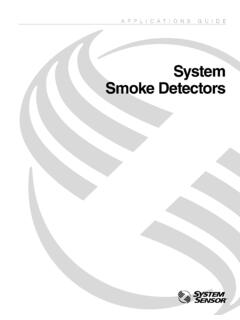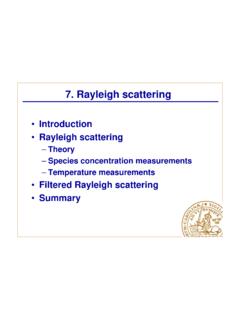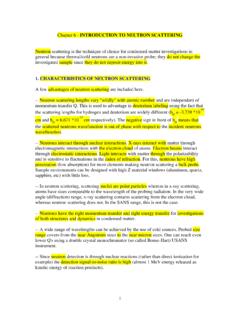Transcription of Compton Scattering - High Energy Physics
1 (revised 4/27/01) Compton ScatteringAdvanced Laboratory, Physics 407 University of WisconsinMadison, Wisconsin 53706 AbstractThe Compton Scattering of the 662 keV gamma rays from the decay ofCs137is measured using a Sodium Iodide detector. The scattered Energy andthe differential cross section are both measured as a function of scatteringangle, and the results are compared to the full relativistic quantum theoryof Compton effect is the elastic Scattering of photons from a reaction, the process is: +e +e .Since this is a two body elastic Scattering process, the angle of the scat-tered photon is completely correlated with the Energy of the scattered photonby Energy and momentum conservation. This relation is usually written as: = =hmc(1 cos )(1)where and are the wavelengths of the incident and scattered photonrespectively, and is the photon Scattering Energy of a photon is related to its frequency and wavelength as:E=h =hc/ (2)wherecis the velocity of light. Combining Eq. (1) and (2) the Energy of thescattered photon is:E =E1 +Emc2(1 cos ).
2 (3)The kinetic Energy of the recoil electron is:Te=E E =E (1 cos )1 + (1 cos )(4)where =h quantityh/mcin Eq. (1) is called the Compton wavelength and hasthe value:h/mc= 10 10cm =.02426 low Energy photons with .02 A, the Compton shift is very small,whereas for high Energy photons with A, the wavelength of thescatteredradiation is always of the order of A, the Compton an example, in this experiment gamma rays from Cs137are scatteredfrom an aluminum target; sinceE= MeV, we have = so thatgamma rays scattered at = 180 will haveE = , which is less2than 1/3 of their original Energy . It thus becomes quite easy to observethe Compton Energy shift. This would not be the case for X-ray useful kinematic relation is the electron Scattering angle in termsof the photon Scattering angle:cot = (1 + ) tan /2where is the electron Scattering angle relative to the incident photon above kinematic relations as well as the following discussion on crosssections may be found in Melissimos pp.
3 252 265 which is required readingfor this mc2the probability for Compton Scattering can be regardedas a classical process and is given by the Thompson cross section which isthe classical limit of the exact Compton Scattering cross section d Thompson=r20(1 + cos2 2)(5)wherer0=e24 0mc2is the classical electron radius and has the valuer0= 10 13cm. When integrated over all Scattering angles, Eq. (5)yields the total Thompson cross section: T=83 r20.(6)This simple cross section has several failings:1. It does not depend on the photon Energy , a fact not supported byexperiment;2. the electron, although free, is assumed not to recoil;3. the treatment is nonrelativistic;4. quantum effects are not taken into problem was solved by Klein and Nishina in 1928 giving the correctquantum-mechanical calculation for Compton Scattering , the so called Klein-Nishima formula:d d =r20(1 + cos2 2)1(1 + (1 cos ))2 [ 2(1 cos )2(1 + cos2 )(1 + (1 cos ))+ 1].(7)3 This result is for the cross section averaged over all incoming photon polar-izations.
4 By integrating Eq. (7) over all angles, the total cross section canbe obtained. While the expression for the total cross section is a lengthyformula, two asymptotic expressions for the total cross section cin the lowenergy and high Energy case are more energies ( 1) c= T{1 2 +265 2+ }and High energies ( 1) c=38 T1 (ln 2 +12).(8)Note that Eq. (5) for the Thompson cross section gives a symmetric angulardistribution of scattered photons ( , the angular distribution is symmetricabout 90 ). The Klein-Nishina formula (Eq. (7)) on the other hand predictsa strongly forward peaked cross section as following table and graph show the Klein-Nishina cross section as afunction of photon Scattering angle. The table is for the .662 MeV gammaray Energy of Cs137, while Fig. 2 shows the angular distribution for a rangeof incident photon UnitsMilliroentgen per hour (mR/h) are units of radiation exposure. Expo-sure indicates the production of ions in a material by radiation, and it isdefined as the amount of ionization produced in a unit mass of dry air atstandard temperature and pressure.
5 The roentgen is the conventional unitfor exposure, whereradiation exposure unit: 1 roentgen = 1 R = 10 4coulomb per , 1 R of radiation produces 10 4C of positive ions in a kilogramof air at standard temperature and pressure, and an equal charge of safety standards are expressed in units ofroentgen equivalentmammalper year (rem/yr). We now relate roentgens to rems via theradunit and theRBEorQF, discussed absorbed dose is the radiation Energy absorbed per kilogram of ab-sorbing material. It is measured in rads, whereabsorbed dose unit: 1 rad = joule per (Degrees)cos ClassicalE(keV)RelativisticE(keV)Klein-N ishima(10 30m2) .. 15In animal tissue it takes about 30 eV or 10 18J to produce an ion pair,and assuming the magnitude of the charge of each ion is 10 19C, thenfor animal tissue1 R 10 10 19C= 10 4 Ckg 30JC= '1 , a 1-R exposure to x rays or rays produces an animal tissue absorbeddose of approximately 1 effects of radiation on biological systems depend on the type of ra-diation and its Energy .
6 Therelative biological effectiveness(RBE) orqualityfactor(QF) of a particular radiation is defined by comparing its effects tothose of a standard kind of radiation, which is usually taken to be 200-keV xrays. The RBE or QF is the ratio of the dose in rads of a particular kind ofradiation to a 1-rad dose of 200-keV x rays, where the particular radiationproduces the same biological effect as the x rays. Note that RBE or QF or QF:Number of rads of a particular kind of radiation1 rad of 200-keV x raysIn animal tissue the RBE is about for x rays, rays, and rays, and itranges from about 2 to 20 for protons, neutrons, and rem is defined asrem dose in rads animal tissue a 1-rad dose of rays is equivalent to an exposure of 1 R,and the RBE is about 1 for rays in animal tissue; therefore, the dose inrems and the exposure in roentgens are standards adopted by the United States Government are thefollowing:1. For workers employed around nuclear facilities: 5 rem/yr, which wouldbe mrem/h continuously while at work for those on a 40-h comparison, 300 to 600 rem of acute whole-body radiation is fatalto For the general population living near a nuclear facility: For worldwide population: 5 rem total up to age 30 ( rem/yr),in addition to natural background radiation, which is about the sameintensity.
7 Primary concern is for genetic damage. It is estimated, ratheruncertainly, that rem/yr may produce 5000 extra deaths and 5000birth defects in the United States per CalculationsThe calculations consist of two parts. First we calculate the attenuationof gammas which is desirable. Then we calculate the thickness of lead to givethis A A source of 100 millicuries (100 mCi) of Cs137gives an exposureof Roentgen/hour (R/hr) at a distance of 1 meter. By theinverse square law, the exposure at the distance of meters isx= R/hr (with no shielding)B This corresponds to a dose equivalentDfor tissue of .415 Converting this to the Dose Equivalent in =D QFwhere QF=1 for gamma we haveDE = rems/hr (if no shielding)D Assume that a student may spend 16 hours/month standing atthis short distance ( meters) from the source. The Dose equiv-alent/year with this occupancy factor is rem/year(if no shielding)E Radiation standards adopted by the (1990) for worldwidepopulation: 5 rem total up to age 30 ( rem/yr), in additionto natural background radiation, which is about the same inten-sity.
8 We will assume that 1 10 3rem/yr is satisfactory for theshielding of our Cs137source. We have therefore designed the leadshielding to give an attenutation factor of:f=1 10 3 rem/yr= 10 shielding calculation (not shown here) for 662 keV gamma raysgives the result that cm of lead will accomplish the aboveattenuation SourceThe gamma source is Cs137. The present source had a nominal strength of100 millicuries when it was purchased in 1975, although the actual strengthappears to have been somewhat smaller. A careful measurement of the sourcestrength in May, 1991, yielded a value of 42 2 is a strong source and so there are 3 very important rules. The decayscheme of Cs137is shown in Fig. 3. The details of the source are shown inFig. Do not attempt to remove the source from inside its lead The container barrel points towards a concrete wall. Do not try tomove the container or Do not place any part of your body within 15 of the barrel axis unlessthe stopper is in the position to block the lead container is designed conservatively so that the dose you wouldreceive if you leaned against the container for 16 hours each month would bestill less than 10% of the allowable dose for students and 2% of the allowabledose for industrial workers.
9 The dose is approximately 1% of the naturalbackground dose. As a result, the lead container weighs about 540 lbs. or250 practice, of course, you will spend less time than 16 hours and will beat a distance which reduces the background intensity 50 Container and BarrelThe container is made of lead and so the 662 KeV gammas have a nearlyequal probability of interacting via the Photo-Electric effect and via theCompton Effect. The most important angle of Scattering is in the forward 45 cone because(a) The differential cross section is larger in the forward direction, and(b) The minimum Energy is lost by the gamma when it is scattered in theforward we require a jet of well collimated 662 KeV gammas with as little con-tamination as possible of gammas with lower energies, the container barrelhas been designed to greatly reduce the chance of gammas escaping after aforward scatter ( <90 ).If a 662 KeV photon is scattered through more than 45 then it is likelyto be absorbed by a small thickness of x/ Angle of Scattering Energy in Lead0 662 keV cm45 479 keV cm90 288 keV cm135 206 keV cm180 184 keV cmThe gammas which do not pass out through the aperture are incidentupon the surfaces A, B, C, D.
10 (See Fig. 5.)A and BA few gammas will Compton Scatter to give 184 MeV gammaswhich scatter to the right. However, the 662 gammas will have penetratedabout cm into the lead and so only a few of the 184 MeV gammaswill escape from inside the AB surfaces. Some gammas will interact via thephotoelectric effect. Both will cause 75 keV X-rays (Lead K shell) but againonly a few X-rays will escape from inside the AB aperture is designed so that scattered gammas and X-rays cannotescape directly from scattered gammas and X-rays cannot escape directly. Althoughthe Compton scatters of 90 to 45 may have enough Energy for a secondCompton scatter on the opposite surface E, the distance they must travelfrom the interaction point in D to leave D is greater than the penetrationinto D. Note that a few gammas will Compton Scatter near the DE cornerand will escape into the main beam. Obviously if we had a ring of denseHIGHZ material such as uranium, at the corner, this background could bereduced. See Fig.







